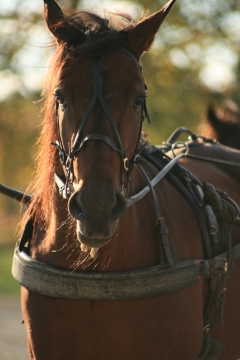Effects of training and feeding on body development, metabolism, performance and health in growing horses
The Swedish University of Agriculture (SLU) and National Centre for Trotting Education, Wången are cooperating in a unique study with the performance and health of Standardbred race horses in focus.
 |
A collaboration betweenSLU and Travskolan Wången |
 |




The results from this project is included in the doctoral thesis:
A Forage-Only Diet and Reduced High Intensity Training Distance in Standardbred Horses ![]()
Growth, Health and Performance ![]()
by Sara Ringmark
Publications:
- S. Ringmark, L. Roepstorff, B. EssénGustavsson, T. Revold, A. Lindholm, U. Hedenström, M. Rundgren, G. Ögren and A. Jansson (2012). Growth, training response and health in Standardbred yearlings fed a forageonly diet. animal, null, pp 18 doi:10.1017/S1751731112002261. Länk till artikeln online HÄR
 . http://journals.cambridge.org/abstract_S1751731112002261. Om träningsrespons, tillväxt och hälsa hos 1,5 åriga travhästar i träning på en foderstat fri från kraftfoder.
. http://journals.cambridge.org/abstract_S1751731112002261. Om träningsrespons, tillväxt och hälsa hos 1,5 åriga travhästar i träning på en foderstat fri från kraftfoder.
- Sara Ringmark, Arne Lindholm, Ulf Hedenström, Michael Lindinger, Kristina Dahlborn, Clarence Kvart and Anna Jansson. 2015. Reduced high intensity training distance had no effect on VLa4 but attenuated heart rate response in 2-3-year-old Standardbred horses. Acta Veterinaria Scandinavica 2015 57:17. http://www.actavetscand.com/content/57/1/17/abstract

{Accordion}
More about the project
Project managers: Anna Jansson, Lars Roepstorff and Karin Ericson
PhD student: Sara Ringmark
Project Group:Jan Halberg, Ulf Hedenström, Roger Persson, Margareta Rundgren, Lars-Åke Swärdfeldt, Malin Connysson, Johanna Svensson, Stig H Johansson,Thomas Uhrberg, Gunilla Ögren, Clarence Kvart, Birgitta Essén-Gustavsson, Tobias Revold, Kerstin Hansson, Kristina Dahlborn, Arne Lindholm, John Pringle and others, students at Wången.
Background
Health problems in the locomotion apparatus is a common reason for both riding horses and trotters not to train and compete in a way owners and trainers hope for. Recent research suggests that diet and physical activity in young horses is important for the adaptation of body tissue to exercise loads. However, long term studies on the impact of feeding and training of young horses on body tissue growth, metabolism, performance and health are scarce.
Training and metabolism
Standardbred race horses start train at a low level by the age of 1,5 years and by the age of two the training intensity increases. This training is associated with large heat production, muscle glycogen utilisation and the production of lactic acid and hydrogen ions, factors that might induce fatigue and increases the risk of tissue overload. Regular intense training may also lead to a gradually depletion of muscle glycogen stores which can be related to a reduced performance. The effect of reducing the amount of high intensity training on health and performance of young Standardbred horses is not known.
To meet the high energy demands of these horses, starch-rich concentrates are used which is known to be associated with colic, gastric ulcers, rhabdomyolysis, stereotypic behaviour and probably also altered cartilage development. However, recent studies indicate that the energy requirements in at least adult Standardbred horses in training can be met by using non-starch feed stuffs. One limitation might however be glycogen repletion, but there are indications that forage-only diets high in both energy and protein may enhance glycogen synthesis which is in accordance with observations in man and rat.
The project has the following hypothesis:
1) It is possible to get Standardbred yearlings in competitive condition at 3 years of age without feeding starch-rich concentrates,
2) Young Standardbred horses subjected to 80 % of the amount of intensive training in conventional training have similar performance and less health problems,
3) The muscle glycogen content will be higher in horses on a reduced training regime and the content can be increased if the crude protein content of the diet is increased.
Implementation
The study will be conducted at the National Centre for Trotting Education, Wången, Sweden. Sixteen Standardbred horses will be used and trained from the age of 1,5 years. The horses will be randomized in to two groups, one that will have a conventional training program and one that will have a training program where the amount of high intensity training will be reduced by 20 %. In the work with composing the training programs Stig H Johansson and Thomas Uhrberg, two of the most successful trainers in Sweden, have taken part and their competence will be used for evaluation of the performance condition. The goal for all horses is to participate in a standardized race (Premielopp) in spring as 2-year olds, a qualifying race in the autumn the same year and start compete in spring as 3-year olds.
The study was financed by National Centre of trotting Education, Wången and the Department of Animal Nutrition and Management at the Swedish University of Agriculture, SLU.
Links

(Photographer: Sophie Maurer)